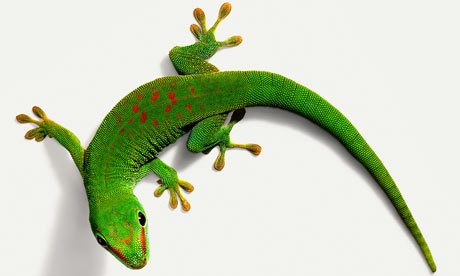Researchers have solved the mystery of what triggers the gecko's famous adhesion mechanism. Gecko-inspired technologies could include robots that scuttle up and down the outsides of spacecraft looking for damage – and spiderman pads

A day gecko. A surface's steepness rather than its slipperiness seems to activate the animal's fierce grip. Photograph: Peter Weber/Getty Images
Geckos are the champion climbers of the vertebrate world, running around on walls and ceilings with insouciant ease.
They have some pretty remarkable adaptations that enable them to do this. Each of their toes is covered with "setae" – tiny projections much thinner than a human hair. Each seta is tipped with hundreds of even finer projections called spatulae, which have a diameter smaller than the wavelength of visible light.
The spatulae stick to walls by van der Waals forces, the electrostatic attraction or repulsion between materials caused by the uneven distribution of charge on their molecules. The same interactions are responsible for the pages in your newspaper sticking together.
These forces allow a gecko to cling to almost any surface, without secreting a sticky substance. Although a gecko only weighs around 90g, it can stick to a ceiling tightly enough to support a weight of around 40kg.
Clearly it would be difficult to move around if you stuck so strongly with every step, so geckos can turn their grip on and off. They switch it on by rolling their toes down and gripping inwards, and detach by rolling the toes upwards and backwards to peel the spatulae off. They're able to do this so quickly that they can attach and detach from a surface 15 times a second.
But until now, scientists have been unsure what triggers the geckos to deploy the gripping mechanism.
In a paper published online today in Proceedings of the Royal Society B, Anthony Russell of the University of Calgary in Canada and Timothy Higham of Clemson University in South Carolina report that the gecko's perception of body orientation determines when it activates the adhesive system.
On a 30-degree slope, all six of the geckos they tested deployed the grip. On a 10-degree slope only three of the geckos did, suggesting that 10 degrees is about the threshold at which the gripping mechanism is activated.
The three geckos that did start clinging at 10 degrees moved more slowly, showing that there are drawbacks to turning on the adhesive system.
"There are costs, in terms of speed, and benefits, in terms of traction, associated with this switch, just as there are for Formula 1 cars when rain tyres are employed instead of slicks when circumstances place a premium on grip over outright speed," said Russell.
The scientists ruled out the possibility that geckos switch on their traction control when they feel their feet slipping. When the geckos ran on a smooth Plexiglas surface their feet slipped – even on a level surface – but this didn't trigger the adhesive system.
Researchers studying how geckos cling to walls and ceilings hope that a better understanding of the process will enable engineers to copy it for robotics and other commercial applications.
A team from Carnegie Mellon University has built robots with ultra-thin fibres on their feet that enable them to climb walls. A similar design could be used to make robots that can scale the outsides of spacecraft to inspect for damage.
Last year a group at the University of California, Berkeley, developed a gecko-inspired adhesive tape covered with microscopic contacts, that only sticks when you try to pull it across a surface. Soon we could be using gecko technology to hang pictures on walls using non-sticky adhesives.
Is it too early to dream of Spiderman-style pads that would enable us to scale walls like geckos? Perhaps not ...
No comments:
Post a Comment